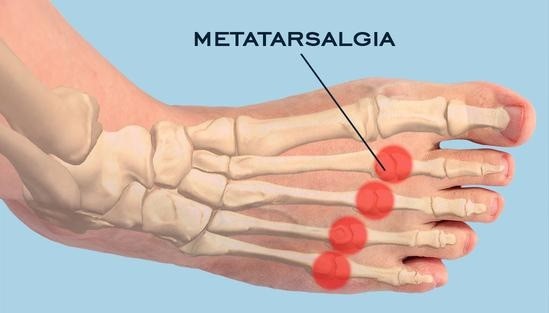
Forefoot pain and deformity decrease the quality of life because of deteriorated gait function. Metatarsalgia, pain in the ball of the foot, is a common orthopedic problem often not understood because it is not clear as heel pain. When the metatarsalgia condition is influenced by Morton’s neuroma, it is known as Metatarsalgia neuroma. Metatarsalgia can be diagnosed by clinical examination and the medical history of the patient. The symptom is at the metatarsophalangeal articulations with electrifying, dull, and burning pain occasionally radiating to the toes. The pain has a V-shape between the second and third toes, at the pressure point of the interphalangeal joint striking against the shoe front. There are diverse causes, but the treatment of the underlying problem is crucial for successful metatarsalgia treatment.
Primary metatarsalgia – This is the uncoordinated relationship between the metatarsal and other parts of the foot. It causes increased MT declination with the first ray unable to bear the weight it transfers the pressure to other areas of the foot.
Secondary metatarsalgia – Is caused by the indirect overloading of the forefoot. For example, trauma to the foot can alter the foot alignment causing rotational and angular displacement. If the structures that support the metatarsal joint are injured or fractured, the biomechanical alignment of the foot is unstable and painful. Other causes of secondary metatarsalgia include Morton’s neuroma, chronic inflammatory diseases, tarsal tunnel syndrome, hallux rigidus, and Freiberg infarction.
Iatrogenic metatarsalgia – This arises from complications after surgery of the forefoot, affecting the MT osteotomy, or having excessive shortening of the MT. Other complications include avascular necrosis, nonunion, or malunion.
Metatarsalgia treatment
The condition deteriorates the biomechanical condition of the foot, increasing pressure on the MT head when bearing weight. Several measures can improve or prevent the condition:
- Put up the feet and rest them and avoid activities that cause pain to the foot, such as active sports that involve lots of jumping or running. Engage in low-impact activities such as swimming or cycling.
- Apply an ice pack for 20 minutes and do it several times a day. Do not apply ice directly to the skin to avoid damage.
- Change your footwear to flat shoes with plenty of room. The sole should be well-cushioned. Choose good sports shoes and replace any worn-out footwear.
- Use shock-absorbing insoles and pads that fit in your shoes that are available in the sports shops, pharmacies, or buy online.
- Adopt a healthy and balanced diet to maintain a healthy weight. Keep low-impact exercises to help you lose weight.
- Take over-the-counter painkillers to relieve swelling and pain.
If the pain gets worse despite the above measures or you experience severe pain that interferes with your normal activities, and if you develop severe foot pain that threatens to change the shape of the foot you need immediate treatment. Metatarsalgia issues can be very uncomfortable to live with. If you are experiencing pain with your metatarsalgia neuroma, contact the podiatrist at DeNiel Foot & Ankle Center. Our doctor can provide the care you need to keep you pain-free and on your feet.
Related Posts
No related posts.

